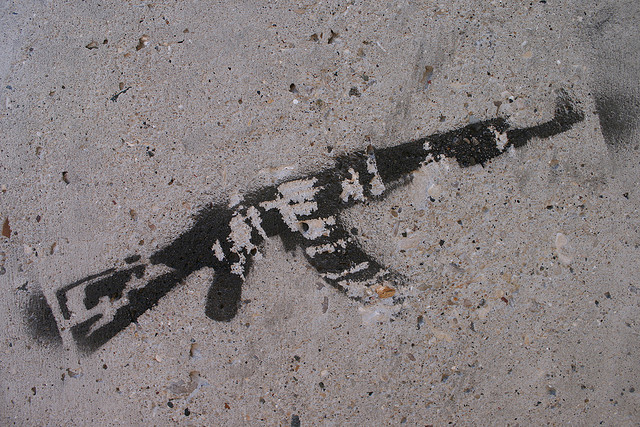Barely a day goes by when ISIL isn’t in the news, or there’s no new report detailing its activities, adroit use of social media or recruiting methods. In the midst of all this, al-Qaeda has not only been relatively quiet but relatively forgotten. There’s a sense that it’s become the ‘moderate’ stream in an increasingly brutal, barbaric and violent Islamist movement. But we shouldn’t forget al-Qaeda’s resilience—and its tendency to be just as brutal, barbaric and bloodthirsty as ISIL.
Today ASPI releases a new report examining what the rise of ISIL means for al-Qaeda and how it may react. How will al-Qaeda seek to regain the oxygen of publicity that’s central to terrorist organisations if they’re to recruit, grow and, ultimately, challenge their enemies?
ISIL poses a genuine threat to security in the Middle East and Western countries. It has sophisticated modes of recruitment, significant funding and a loyal following in the West. It’s arguably the most threatening terrorist group in operation. However, it also threatens al-Qaeda. ISIL has overtaken al-Qaeda to become the ‘organisation of choice’ for aspiring jihadis. In this sense, al-Qaeda is being outmanoeuvred and outplayed at its own game, losing the manpower and military means that it needs to achieve its political ambitions.
For al-Qaeda, something has to give if it’s going to survive. Based on the available evidence, there are four potential scenarios for al-Qaeda’s response:
- Status quo: uneasy bedfellows
Al-Qaeda has only limited human and financial resources; its adherents in Europe are essentially autonomous and lie beyond the reach and control of al-Zawahiri and the historical leadership of Al-Qaeda Core (AQC). The franchises in Yemen, North Africa, Indonesia and India remain semi-autonomous but are equally deprived of the capability to launch international attacks to recapture the imagination and support of aspiring jihadis. Direct confrontation with ISIL isn’t feasible, not least because it would cause further schisms in the global jihadi movement and alienate the remnants of al-Qaeda’s support base. Left with little option other than to muddle through in the hope that ISIL is a flash in the pan rather than the resilient organisation that al-Qaeda has proven itself to be, AQC elects for an uneasy stance of tolerating ISIL, neither supporting nor opposing it. In short, rather than seeking to challenge ISIL ideologically or militarily, al-Qaeda accommodates ISIL as an uneasy bedfellow in the wider global jihadi movement.
- Merger: putting differences aside
AQC recognises that its ability to conduct spectacular attacks is currently diminished, and that it doesn’t have sufficient resources to achieve its political objectives. Rather than seeking to recapture the imagination of its supporters and increase recruitment, it seeks a formal alliance with ISIL. In joining forces, al-Zawahiri must put to one side the abiding differences between the two groups’ strategic visions by forming a pact with Abu Bakr al-Baghdadi; the merger leads to wider sharing and pooling of resources and exchanges of fighters for specific operations and helps to build a genuinely global jihadi alliance.
- Wither: the failure of confrontation
Al-Qaeda seeks to regain the limelight and the support of the wider jihadi movement by confronting ISIL directly, both militarily through Jabhat al-Nusra and reputationally through its media channels. However, its efforts will fail: ISIL is more adept in its media campaign and has sufficient military resources to counter Jabhat al-Nusra. Al-Qaeda loses precious financial and military resources, compounding failure. Continued attempts to rectify the situation result in further losses and, as the movement attenuates, members increasingly defect to ISIL. Over time, al-Qaeda loses its identity before becoming effectively defunct as its remaining members flock to ISIL.
- A spectacular attack: a game of one-upmanship
Al-Qaeda channels some of its remaining resources into a spectacular centrally-organised and funded attack. If successful, the attack allows it to regain the headlines and experience a surge in popularity, reputation and, ultimately, recruitment. Having recaptured the limelight, al-Qaeda plots further attacks of a similar magnitude using its new-found resources. As al-Qaeda slowly regains its position as the ‘terrorist group of choice’ for aspiring jihadis, members of ISIL begin to defect to the more internationalist and globally organised al-Qaeda. ISIL, recognising that it’s losing ground to a rejuvenated al-Qaeda, plots significant attacks in an effort to regalvanise the organisation and hold on to its recruits. As its attacks succeed, it recaptures the imagination of its supporters and experiences increased recruitment and popularity. This game of one-upmanship drives each party to increase the ferocity of its campaigns.
All four options are feasible, yet the first three options are marginally less likely than the final—and most worrying—scenario: al-Qaeda pursues a campaign of international attacks in order to regain the limelight. There are a number of reasons for this.
First, al-Qaeda has, throughout its long and bloody history, shown itself to be a resilient organisation, remarkably adept in exploiting weaknesses in its political environment. Second, while al-Qaeda has been significantly challenged by ISIL, it has shown, not least in Yemen and North Africa, that it still has a loyal following and can still perpetrate significant acts of terrorist violence. Third, al-Qaeda has historically been at its most dangerous when the international community has taken its eye off the ball: in 2000, opportunities were missed to dismantle the nascent organisation, which resulted in the attacks of 9/11. Similarly, in 2005, AQAP was all but defeated, but Western governments turned their attention elsewhere and allowed the organisation to re-establish itself.
ISIL is a real threat and must be targeted, but al-Qaeda shouldn’t be forgotten. It’s a resilient and resolute terrorist organisation but it’s also weaker than it has been for many years. We should use this brief opportunity to dismantle the organisation completely.


